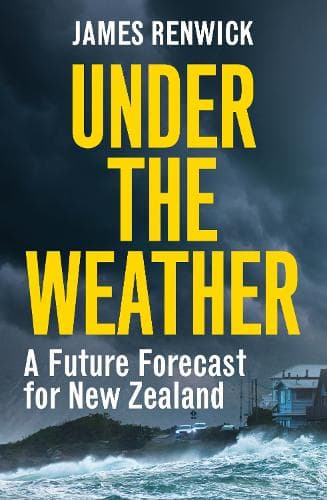Review: Under the Weather: A Future Forecast for New Zealand
Reviewed by Alex Eagles
In his recently released book Under the Weather: A future forecast for New Zealand, James Renwick tackles one of the most contentious issues since the theory of evolution - climate change.
Renwick writes that he has had his 'head in the clouds' ever since training as a meteorologist four decades ago. But the Victoria University Professor is not only a leading climate scientist on the New Zealand Climate Change Commission - He Pou a Rangi. He has also been involved with an alphabet of national and international climate organisations during the years from the IPCC and WCRP, to the CliC and NZASP.
In Under the Weather, he is able to convey information concerning the changing climate in an easy-to-read style, often using similes for complicated concepts, such as making a cup of tea, a pinball machine and Taylor Swift. The result allows readers, especially non-scientists, to more easily comprehend the processes that have created climatic changes from millions to hundreds of years and, more recently, decades to yearly.
Renwick explains that weather is only one piece in the climate jigsaw puzzle and answers arguments unbelievers might pose gently but firmly with scientific data and humour. As someone who has rewritten jargon-filled scientific articles for the consumption of non-experts in the past, I assure you what Renwick achieves in this book is no mean feat. It’s no wonder he was awarded the Prime Minister's Science Communication Prize in 2018.
Under the Weather is broken down into four parts. The first chapters give a fascinating overview of the global climate from past to present. Renwick describes the Earth's climate as a dynamic system where wind and ocean currents constantly try to even out global temperatures by moving warm air/water from the equator to the poles but with each new dawn, the sun shines with greater intensity on the equator than the poles, and so the dance goes on. He also elucidates how events like La Niña, sunspots and volcanic eruptions constantly throw researchers off the mark.
Part II is about Aotearoa, where the weather is integral to our lifestyle and economy. Renwick explains why our long narrow nation, floating in the middle of the Pacific Ocean, with its northern tip almost in the tropics and southernmost point 'within waving distance of Antarctica,’ is prone to rapid weather changes. The book's third section focuses on the forecast for our future with best (if we act now) and worst-case (if we do nothing) scenarios. The last section outlines remedies to reduce the rate of climate change. As Renwick himself says, people have become desensitised to tales of climate doom and gloom with many ignoring the warnings. The book could have started with the lists of small steps each of us can take to reduce carbon emissions and, more importantly, things we should be campaigning for from local councils and central government politicians when they make local and national changes.
My favourite suggestion was for Aotearoa to have a freight and passenger railway network to every town with a station to reduce the need for road travel. Imagine a law passed for all freight to go by train as far as possible to minimise the number of big trucks on our roads! Renwick's suggestions that New Zealand could win the world cup for reducing carbon emissions would have made a great opening sentence. His reminders of how our tiny nation was world-leading in our nuclear-free stance, Covid-19 response and rejoinder following the Christchurch terrorist attacks are far more potent than the frightening reminders of what will happen if carbon emissions continue at the same rate.
Still, Under the Weather is a must-read for anyone with questions about climate change and would make a fantastic educational resource for secondary and tertiary students, especially if reprints included an index.
Reviewed by Alex Eagles
